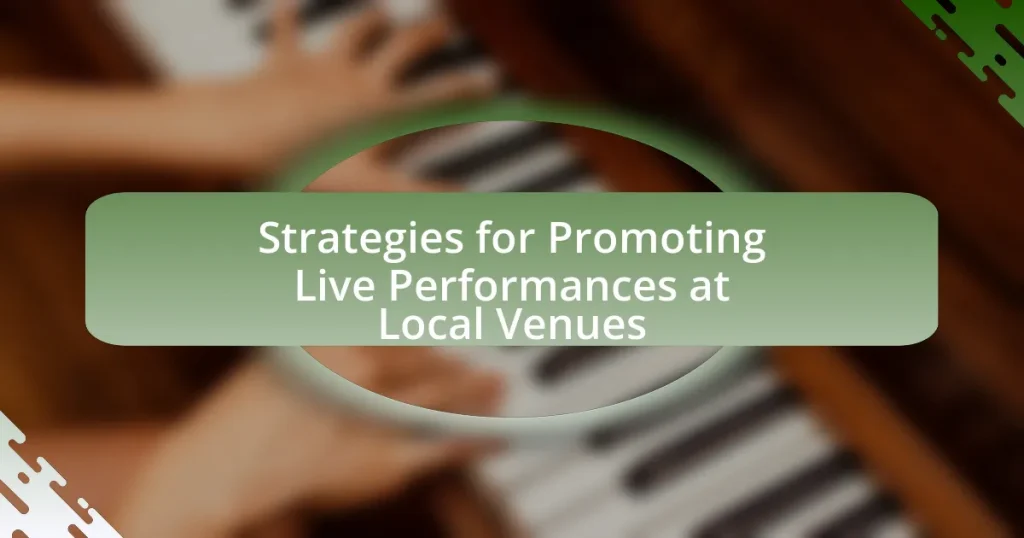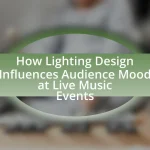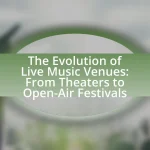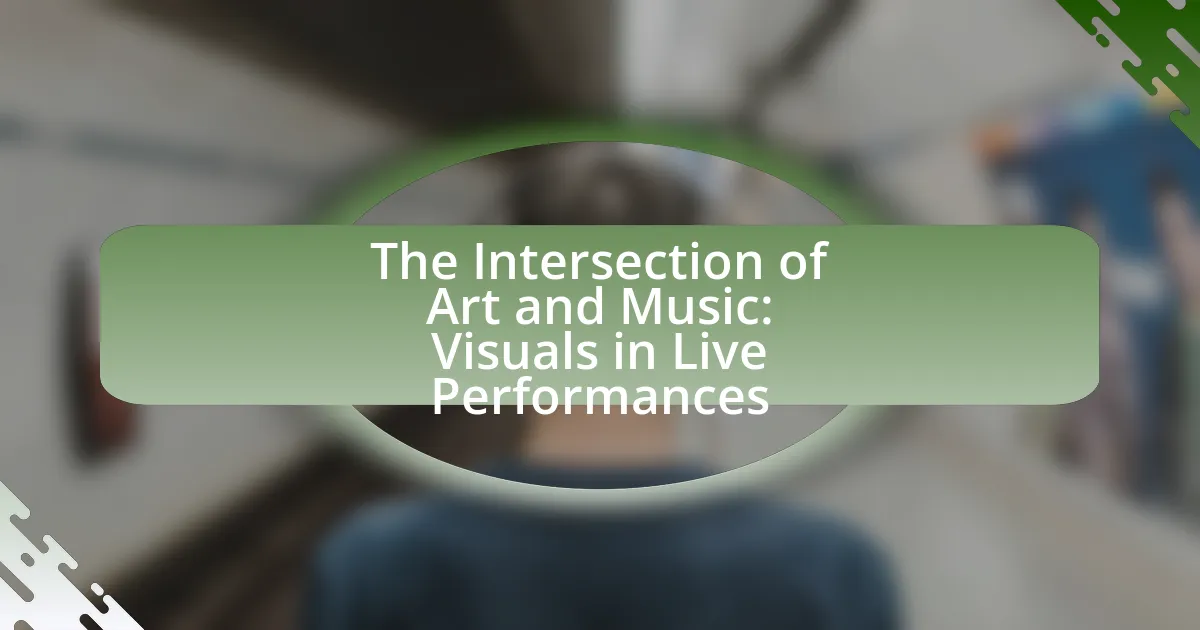The article focuses on effective strategies for promoting live performances at local venues, emphasizing the importance of social media, collaborations with local influencers, and targeted advertising. It outlines methods for identifying target audiences through demographic analysis and audience engagement metrics, while also discussing key demographic factors that influence marketing strategies. Additionally, the article highlights the role of partnerships with local businesses and community organizations, as well as traditional marketing methods such as print advertising and community events. It concludes with insights on digital marketing strategies, including email marketing and website optimization, to enhance visibility and drive attendance for live performances.
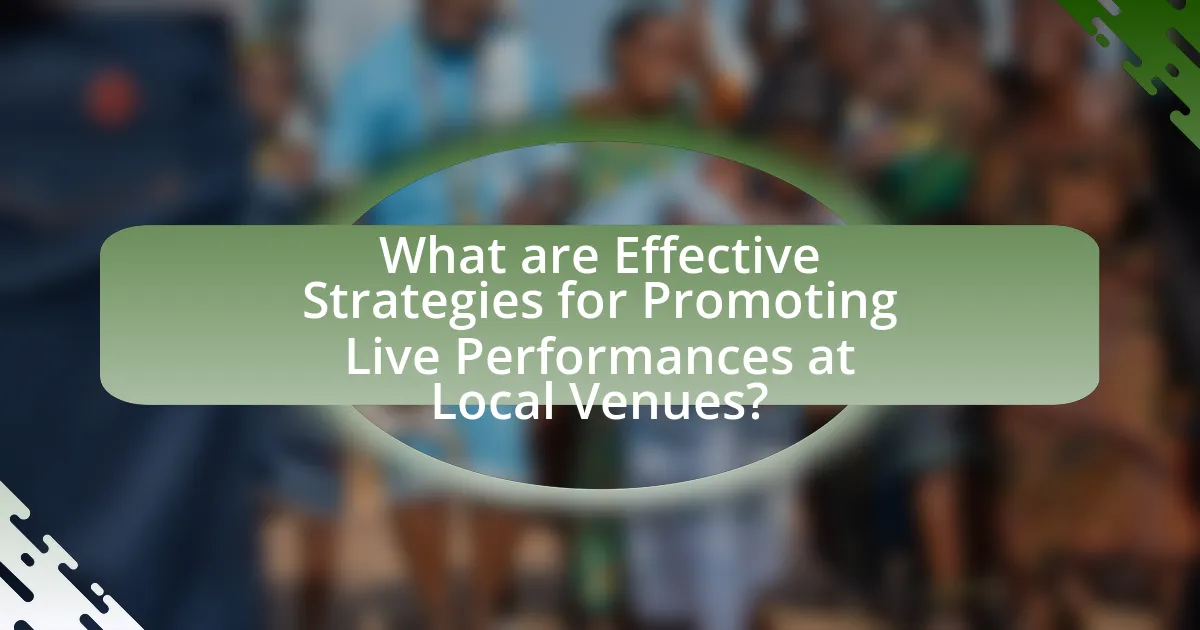
What are Effective Strategies for Promoting Live Performances at Local Venues?
Effective strategies for promoting live performances at local venues include leveraging social media, collaborating with local influencers, and utilizing targeted advertising. Social media platforms like Facebook and Instagram allow venues to reach a broad audience quickly, with 54% of users reporting they use these platforms to discover events. Collaborating with local influencers can enhance visibility, as their followers often trust their recommendations, leading to increased ticket sales. Targeted advertising, particularly through platforms like Google Ads and Facebook Ads, enables venues to reach specific demographics, ensuring that promotional efforts are directed toward individuals most likely to attend. These strategies are supported by data indicating that targeted marketing can increase engagement rates by up to 50%.
How can local venues identify their target audience for live performances?
Local venues can identify their target audience for live performances by analyzing demographic data, conducting surveys, and utilizing social media insights. Demographic data, such as age, gender, and location, can be gathered from ticket sales and event attendance records, providing a clear picture of who is attending performances. Surveys can be distributed to patrons to gather information on their preferences, interests, and feedback on past events, which helps refine the understanding of the audience. Additionally, social media platforms offer analytics tools that reveal audience engagement metrics, such as likes, shares, and comments, allowing venues to gauge interest in specific genres or types of performances. This multifaceted approach ensures that local venues can tailor their programming to meet the preferences of their identified target audience effectively.
What demographic factors should be considered when targeting audiences?
When targeting audiences for live performances at local venues, key demographic factors include age, gender, income level, education, and geographic location. Age influences preferences for music genres and performance styles; for instance, younger audiences may favor contemporary acts, while older demographics might prefer classic performances. Gender can affect marketing strategies, as different genders may respond to various promotional messages and channels. Income level determines the affordability of ticket prices and spending on entertainment, while education can influence cultural interests and engagement levels. Geographic location is crucial, as it affects accessibility and the types of performances that resonate with local communities. Understanding these factors allows for tailored marketing strategies that effectively reach and engage specific audience segments.
How can local venues gather data on audience preferences?
Local venues can gather data on audience preferences through surveys, social media analytics, and ticket sales analysis. Surveys distributed via email or at events can directly ask attendees about their interests and preferences, providing quantitative and qualitative insights. Social media platforms offer analytics tools that track engagement and audience demographics, helping venues understand what content resonates with their audience. Additionally, analyzing ticket sales data reveals trends in popular events, genres, and times, allowing venues to tailor their offerings to meet audience demand. These methods collectively enable local venues to make informed decisions that enhance audience satisfaction and drive attendance.
What role does social media play in promoting live performances?
Social media serves as a crucial tool for promoting live performances by enabling artists and venues to reach a broader audience quickly and effectively. Platforms like Facebook, Instagram, and Twitter allow for real-time updates, event promotion, and audience engagement, which can significantly increase ticket sales and attendance. For instance, a study by Eventbrite found that 93% of event creators use social media to promote their events, highlighting its importance in the marketing strategy for live performances. Additionally, social media facilitates user-generated content, where attendees share their experiences, further amplifying the reach and visibility of the event.
Which social media platforms are most effective for local venues?
Facebook and Instagram are the most effective social media platforms for local venues. Facebook’s extensive user base allows venues to create event pages, share updates, and engage with the community, while Instagram’s visual focus enables venues to showcase performances and atmosphere through photos and videos. According to a 2021 survey by Eventbrite, 70% of event organizers reported that social media was their most effective marketing tool, with Facebook and Instagram leading in engagement rates.
How can venues create engaging content to attract audiences on social media?
Venues can create engaging content to attract audiences on social media by showcasing behind-the-scenes footage, highlighting upcoming events, and featuring artist interviews. This approach personalizes the venue experience, making it relatable and inviting. For instance, a study by the Pew Research Center indicates that 69% of adults in the U.S. use social media, making it a vital platform for reaching potential attendees. Additionally, using visually appealing graphics and interactive content, such as polls or contests, can significantly increase audience engagement, as posts with images receive 650% higher engagement than text-only posts.
What partnerships can local venues form to enhance promotion?
Local venues can enhance promotion by forming partnerships with local businesses, community organizations, and media outlets. Collaborating with local businesses, such as restaurants and shops, allows venues to create cross-promotional deals, attracting customers from each other’s clientele. For instance, a venue could partner with a nearby restaurant to offer discounts for patrons attending performances, thereby increasing foot traffic for both entities.
Additionally, partnering with community organizations, such as schools or non-profits, can help venues tap into local networks and gain access to new audiences. These organizations often have established relationships within the community, which can be leveraged for promotional events or fundraisers that highlight the venue’s offerings.
Furthermore, collaborating with local media outlets, including radio stations and newspapers, can amplify promotional efforts through advertising and event coverage. For example, a venue could work with a local radio station to host a live broadcast of a performance, reaching a wider audience and generating buzz.
These partnerships not only enhance visibility but also foster a sense of community, making local venues more appealing to potential attendees.
How can collaborations with local businesses boost visibility?
Collaborations with local businesses can significantly boost visibility by leveraging their established customer bases and community trust. When a venue partners with local businesses, it can access a wider audience through cross-promotion, such as joint marketing campaigns or events. For instance, a local restaurant might promote a live performance at a nearby venue through its social media channels, reaching its patrons who may not be aware of the event otherwise. This strategy not only enhances the venue’s exposure but also fosters a sense of community, encouraging local residents to support both the venue and the business. Studies show that businesses that engage in local collaborations experience increased foot traffic and customer engagement, further validating the effectiveness of such partnerships in enhancing visibility.
What benefits do sponsorships provide for promoting live performances?
Sponsorships provide significant financial support and increased visibility for promoting live performances. This financial backing allows event organizers to allocate resources towards marketing, production quality, and artist compensation, enhancing the overall experience for attendees. Additionally, sponsors often leverage their networks and platforms to promote the event, reaching a broader audience. For instance, a study by the Event Marketing Institute found that 74% of consumers have a more positive perception of a brand after it sponsors an event, indicating that sponsorships can effectively enhance brand image while simultaneously driving ticket sales and attendance for live performances.

How can local venues utilize traditional marketing methods for promotion?
Local venues can utilize traditional marketing methods for promotion by leveraging print advertising, direct mail, and community engagement. Print advertising, such as flyers and posters, can be strategically placed in high-traffic areas to attract local audiences, while direct mail campaigns can target specific demographics with personalized invitations to events. Community engagement through partnerships with local businesses and participation in community events can enhance visibility and foster relationships, leading to increased attendance. According to a study by the American Marketing Association, 79% of consumers respond positively to direct mail, indicating its effectiveness in reaching potential attendees.
What types of print materials are effective for promoting live performances?
Effective print materials for promoting live performances include posters, flyers, brochures, and postcards. Posters are visually impactful and can be placed in high-traffic areas to attract attention, while flyers are cost-effective for distribution at events or local businesses. Brochures provide detailed information about the performance and venue, appealing to audiences seeking more context. Postcards can serve as personal invitations, enhancing engagement. Research indicates that 70% of consumers remember a brand better when they receive direct mail, underscoring the effectiveness of these print materials in reaching potential attendees.
How can flyers and posters be strategically placed for maximum impact?
Flyers and posters can be strategically placed for maximum impact by targeting high-traffic areas where the target audience frequents, such as community centers, cafes, and local businesses. Research indicates that visibility in locations with high foot traffic increases engagement; for instance, placing materials near entrances or waiting areas can capture attention effectively. Additionally, utilizing community boards and event spaces ensures that the promotional materials reach individuals interested in local events. Studies show that color contrast and clear messaging on flyers enhance recall, making it crucial to design eye-catching visuals that convey essential information quickly.
What role do local newspapers and magazines play in promotion?
Local newspapers and magazines play a crucial role in promoting live performances at local venues by providing targeted exposure to community audiences. These publications often feature event listings, reviews, and articles that highlight upcoming performances, which helps to inform and engage local residents. For instance, a study by the Pew Research Center found that 56% of adults in the U.S. read local news, indicating a significant reach within communities. Additionally, local publications often have established relationships with their readership, fostering trust and encouraging attendance at promoted events. This localized approach not only enhances visibility for performers but also supports community engagement in the arts.
How can local venues leverage community events for promotion?
Local venues can leverage community events for promotion by actively participating in and sponsoring these events to increase visibility and engagement. By hosting or collaborating on community events, venues can showcase their space, attract potential customers, and build relationships with local organizations. For instance, a study by the National Endowment for the Arts found that venues involved in community activities saw a 30% increase in foot traffic during event periods, demonstrating the effectiveness of such strategies in enhancing local presence and customer loyalty.
What types of community events can be used to promote live performances?
Community events that can effectively promote live performances include music festivals, art fairs, farmers’ markets, and cultural celebrations. These events attract diverse audiences and create an engaging atmosphere where live performances can be showcased. For instance, music festivals often feature multiple acts, drawing large crowds and providing exposure for performers. Art fairs allow local musicians to perform while attendees explore visual art, enhancing the overall experience. Farmers’ markets not only support local agriculture but also provide a platform for live music, fostering community engagement. Cultural celebrations, such as parades or heritage festivals, highlight local talent and encourage participation from the community, thereby increasing visibility for live performances.
How can venues engage with the community to build a loyal audience?
Venues can engage with the community to build a loyal audience by hosting local events that reflect community interests and values. By organizing activities such as open mic nights, community festivals, or workshops, venues create opportunities for local talent to showcase their skills, fostering a sense of belonging and ownership among community members. Research indicates that venues that actively involve local artists and organizations see a 30% increase in attendance and audience loyalty, as these events resonate more with the community’s identity and preferences. Additionally, leveraging social media platforms to promote these events and gather feedback enhances community engagement, ensuring that the venue remains relevant and connected to its audience.
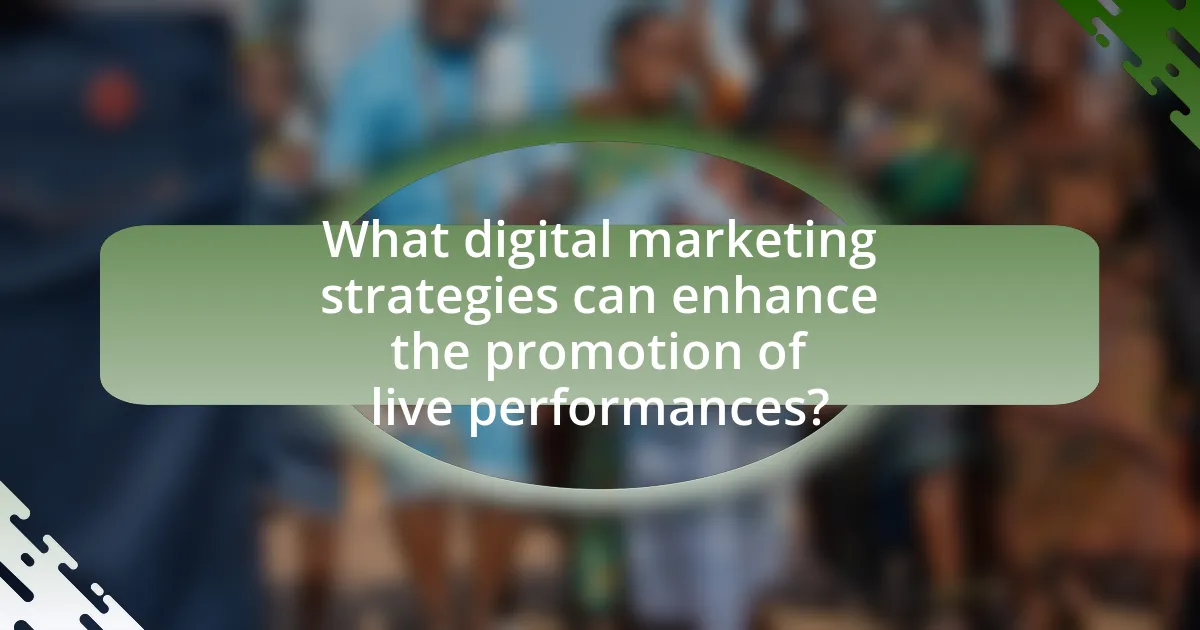
What digital marketing strategies can enhance the promotion of live performances?
Digital marketing strategies that can enhance the promotion of live performances include social media marketing, email marketing, content marketing, and search engine optimization (SEO). Social media marketing allows for targeted advertising and engagement with potential attendees, as platforms like Facebook and Instagram have tools to reach specific demographics. Email marketing enables direct communication with fans, providing updates and exclusive offers, which can increase ticket sales. Content marketing, such as creating engaging videos or blog posts about the performances, can generate interest and shareability. SEO improves online visibility, ensuring that when potential attendees search for events, the live performances appear prominently in search results. According to a study by Eventbrite, 93% of event creators use social media to promote their events, highlighting its effectiveness in reaching audiences.
How can email marketing be effectively used for promoting events?
Email marketing can be effectively used for promoting events by creating targeted campaigns that engage potential attendees and provide essential event details. By segmenting the email list based on demographics and past attendance, marketers can tailor messages that resonate with specific audiences, increasing the likelihood of ticket sales. According to a study by the Direct Marketing Association, email marketing has an average return on investment of $42 for every dollar spent, demonstrating its effectiveness in reaching and converting potential attendees. Additionally, incorporating compelling visuals, clear calls to action, and exclusive offers in the emails can further enhance engagement and drive attendance.
What types of content should be included in promotional emails?
Promotional emails should include engaging content such as event details, special offers, and compelling visuals. Event details should encompass the date, time, location, and featured performers to inform recipients about the specifics of the live performance. Special offers, such as discounts or early bird ticket pricing, create urgency and incentivize purchases. Compelling visuals, including high-quality images or videos of past performances, enhance the email’s appeal and capture the audience’s attention. According to a study by Campaign Monitor, emails with images receive 42% more clicks than those without, highlighting the importance of visual content in promotional emails.
How can venues segment their email lists for targeted promotions?
Venues can segment their email lists for targeted promotions by categorizing subscribers based on demographics, past attendance, and engagement levels. For instance, venues can create segments for different age groups, such as millennials or seniors, to tailor promotions that resonate with each demographic’s preferences. Additionally, analyzing past attendance data allows venues to identify loyal customers and infrequent attendees, enabling them to send personalized offers that encourage repeat visits or attract new audiences. Engagement metrics, such as open rates and click-through rates, can further refine segmentation by identifying highly engaged subscribers versus those who may need more incentive to participate. This targeted approach increases the effectiveness of promotions, as evidenced by studies showing that personalized marketing can lead to a 20% increase in sales.
What role does a venue’s website play in promoting live performances?
A venue’s website serves as a crucial platform for promoting live performances by providing essential information and facilitating ticket sales. The website acts as the primary digital presence where potential attendees can find details about upcoming events, including dates, times, and performers. Additionally, it often features promotional content such as videos, images, and artist bios that enhance audience engagement. According to a study by Eventbrite, 80% of event attendees visit the event’s website for information before making a purchase decision, highlighting the website’s role in influencing ticket sales. Furthermore, an optimized website can improve search engine visibility, attracting more visitors and increasing the likelihood of attendance at live performances.
How can venues optimize their websites for better visibility?
Venues can optimize their websites for better visibility by implementing effective search engine optimization (SEO) strategies. This includes using relevant keywords related to live performances, ensuring mobile-friendliness, and improving site speed, which are critical factors for search engine rankings. According to a study by Google, 53% of mobile users abandon sites that take longer than three seconds to load, highlighting the importance of site speed. Additionally, venues should create high-quality, engaging content that attracts visitors and encourages sharing, as content marketing can significantly enhance online visibility. By integrating local SEO practices, such as including location-based keywords and registering on Google My Business, venues can further improve their chances of appearing in local search results, which is essential for attracting nearby audiences.
What essential information should be included on a venue’s event page?
A venue’s event page should include the event title, date, time, location, ticket pricing, and a brief description of the event. The event title clearly identifies what attendees can expect, while the date and time provide essential scheduling information. The location specifies where the event will take place, which is crucial for potential attendees. Ticket pricing informs visitors about the cost of attendance, and a brief description offers insights into the event’s content, helping to attract interest. Including these elements ensures that potential attendees have all necessary information to make informed decisions about attending the event.
What are some best practices for promoting live performances effectively?
To promote live performances effectively, utilize a multi-channel marketing approach that includes social media, email marketing, and local partnerships. Social media platforms like Facebook and Instagram allow for targeted advertising and engagement with potential attendees, while email marketing can keep your audience informed about upcoming events and exclusive offers. Collaborating with local businesses, such as cafes or shops, can enhance visibility through cross-promotion, reaching a wider audience. According to a study by Eventbrite, 80% of event attendees discover events through social media, highlighting its importance in promotion.
How can venues measure the success of their promotional strategies?
Venues can measure the success of their promotional strategies by analyzing key performance indicators (KPIs) such as ticket sales, audience attendance, and engagement metrics. For instance, a venue can track the number of tickets sold before and after a promotional campaign to determine its effectiveness. Additionally, monitoring social media engagement, such as likes, shares, and comments related to promotional content, provides insight into audience interest and reach. Surveys conducted post-event can also yield valuable feedback on how attendees learned about the event, further clarifying which promotional strategies were most impactful.
What common mistakes should be avoided in promoting live performances?
Common mistakes to avoid in promoting live performances include inadequate audience targeting, poor marketing timing, and lack of engagement with potential attendees. Inadequate audience targeting can lead to low attendance, as promotions may not reach individuals interested in the specific genre or event. Poor marketing timing, such as promoting too late or during competing events, can diminish visibility and interest. Additionally, a lack of engagement, such as failing to interact with fans on social media or neglecting to provide updates, can result in diminished excitement and attendance. These mistakes can significantly impact the success of live performances, as evidenced by numerous case studies showing that targeted marketing and timely engagement are crucial for maximizing audience turnout.
